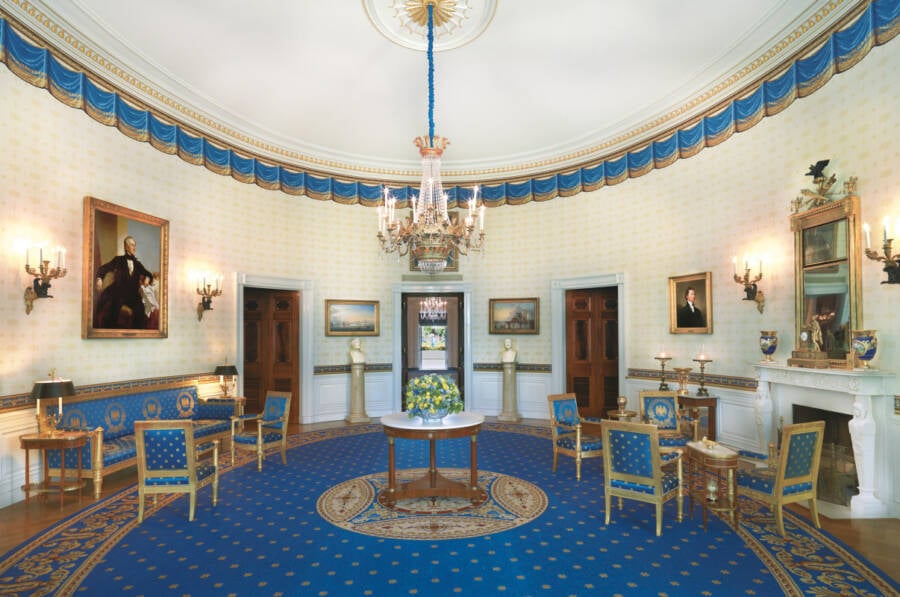From the end of World War II to President Richard Nixon’s Watergate recordings, the Oval Office has served as a backdrop for countless historic events.
The Oval Office is one of the most well-known rooms in the U.S. For decades, it’s been the main backdrop for the American presidency: the stage for international encounters, tense meetings, and addresses to the nation. But the Oval Office has changed significantly over the years.
For starters, the office itself is a somewhat recent development. It’s only since the presidency of William Howard Taft (1909-1913) that the first iteration of the Oval Office was built, and only since the presidency of Franklin D. Roosevelt (1933-1945) that the Oval Office was placed at its present location, in the southeast corner of the West Wing, near the Rose Garden.
In the gallery above, look through some historic photos of the Oval Office as it changed over the last century. And below, learn more about where American presidents have traditionally worked.
The Origins Of The Oval Office
Arguably, the concept of an oval office began with George Washington. Before he moved into the President’s House in Philadelphia in the 1790s, Washington expressed his desire for an oval room, which he may have possibly wanted as a space to meet prominent guests. According to the White House Historical Association, Washington’s preference for an oval room may have inspired the White House’s oval-shaped Blue Room.

White House Historical Association Historians believe that the Oval Office was modeled after the White House’s Blue Room, seen here in this photo during the administration of Barack Obama.
After the White House in Washington, D.C. was ready for occupancy in 1800, presidents worked in different spaces in the building. Thomas Jefferson, for example, worked in today’s State Dining Room, while John Quincy Adams worked on the east side of the White House’s second floor. But after the construction of the West Wing during Theodore Roosevelt’s administration, there was an opportunity to create a designated office for the president.
After the inauguration of William Howard Taft in 1909, the new president held a competition in order to find an architect to design the president’s new, permanent office. The winning architect, Nathan C. Wyeth, seemingly modeled the president’s office after the oval-shaped Blue Room.
This space became known as the Oval Office. From Taft onward, every president occupied it, although one — Woodrow Wilson — briefly moved his office outdoors after a doctor recommended he get more fresh air.
How The Oval Office Changed Throughout The 20th Century And Beyond

Public DomainPresident Herbert Hoover, seen here in this photo visiting the White House after a 1929 fire, restored the Oval Office and added air conditioning to the space.
The first major changes to the Oval Office came after a catastrophe. On Christmas Eve 1929, a devastating fire spread through the White House. In the aftermath, President Herbert Hoover restored the office, but decided to make one important change. He added air conditioning.
His successor, Franklin D. Roosevelt, would make more dramatic changes to the office. During renovations to the White House in 1934, Roosevelt moved the Oval Office to the southeast corner of the West Wing, overlooking the Rose Garden. This change allowed Roosevelt to navigate more easily from the Oval Office to the Residence in his wheelchair, and every president since Roosevelt has worked in this same location.
According to White House historian William Peale, Roosevelt also decorated the office “somewhat more elaborately than [his] predecessor.” Though past presidents had kept the walls of the office fairly blank, Roosevelt furnished them with prints of naval ships (he was the former Assistant Secretary of the Navy) and the Hudson River (where Roosevelt grew up).
Roosevelt was also the first known president to install recording devices in the Oval Office, a practice that many of his successors would follow. Years later, during the presidency of Richard Nixon, his own recordings ultimately became a crucial piece of evidence during the Watergate scandal.

Public DomainA photo of the Oval Office during the Jimmy Carter administration.
Other presidents made changes as well. Harry Truman, for example, was the first to have the presidential seal placed on the Oval Office carpet. John F. Kennedy put a new carpet in, but it would later be replaced during Lyndon B. Johnson’s presidency. Meanwhile, Joe Biden used a dark blue rug that was originally designed for Bill Clinton, which Donald Trump replaced with a lighter rug that had been used by Ronald Reagan.
Indeed, while the bones of the Oval Office have remained the same since Franklin D. Roosevelt, all presidents have added their own decorative touches. Nixon, for example, hung a photo of Earth taken from space. George W. Bush installed a bust of Winston Churchill, which had been gifted to him by British Prime Minister Tony Blair. And Barack Obama included busts of Abraham Lincoln and Martin Luther King Jr.
As such, the appearance of the Oval Office has changed greatly over the 20th and 21st centuries; it constantly transforms to fit the president who sits in the office. But the office’s role in society remains the same. Today, the Oval Office is still a famous symbol of the U.S. presidency and its power.
In the gallery above, see some of the most famous photos of the Oval Office, from the days of William Howard Taft to Donald Trump.
Next, look through these fascinating facts about U.S. presidents. Or, go inside the stories of presidential sex scandals that stunned the nation.
